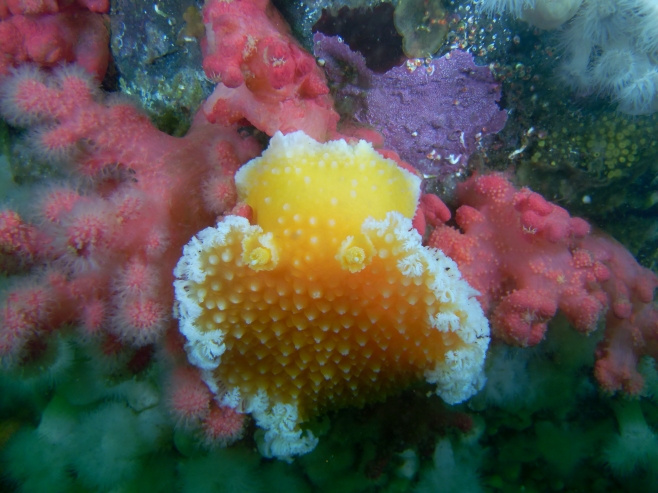Big Orange Love – The Orange Peel Nudibranch
Update November 2020: The Orange Peel Nudibranch has been reclassified to now be Tochuina gigantea. See source below.
Here’s a Valentine’s related blog item. It’s all about Big Orange Love – the reproduction of the Orange Peel Nudibranch (Tochuina gigantea).

These sea slugs are very aptly named since their skin is reminiscent of both the texture and vibrant colour of an orange. But, the name does nothing to indicate the size to which these giants can grow. They are one of the world’s largest sea slugs with literature reporting them to lengths of up to 30 cm and weight to 1.4 kg.
As if this sea slug species’ colour, size and beautifully intricate white gills are not enough to create awe, you should see their eggs! I will never forget the first time I saw the huge tubular mass that looked like udon noodles. I think my brain almost exploded and I was propelled all the more feverishly on my “The Marine Detective” path, wanting to be able to identify the egg masses of all sea slugs in our waters (each species’ eggs look different).
This is the time of year when the Orange Peel Nudibranchs mate and lay eggs.
It’s all to be seen on my “Big Orange Love” slideshow below (note that this slide show is from before the species was reclassified to be Tochuina gigantea).




Orange Peel Nudibranch feeding on Red Soft Coral ©Jackie Hildering.








Sources:
Korshunova T, Martynov A (2020) Consolidated data on the phylogeny and evolution of the family Tritoniidae (Gastropoda: Nudibranchia) contribute to genera reassessment and clarify the taxonomic status of the neuroscience models Tritonia and Tochuina. PLoS ONE 15(11): e0242103. https://doi.org/10.1371/journal.pone.0242103
6 Responses to “Big Orange Love – The Orange Peel Nudibranch”
Hey Jackie. The pictures are gorgeous as always. Couple of questions (if you don’t mind of course) 1) How deep do you have to go to find these nudibranchs? 2) Any idea how many eggs are in that bowl of noodles and how many survive? 3) In the last picture (before you) is a nudibranch and to the left of that is a round balloon like creature. It looks like a jellyfish. What is that?
Sorry, hope you don’t mind being the teacher for a sec 🙂 These creatures just intrique me, that’s all. Apparently we can find them here in the Arabian Gulf too. Haven’t seen any yet though. xxx
Hello Yvonne,
So appreciate your interest – of course.
The white “balloon like creature” is a retracted anemone (species “Snakelock”.
Depth for the orange peel nudibranch = not deep at all. They are really abundant at about 60′ (20 m). I have seen them shallower (to about 30’/10m) and they are also found much deeper (at least to 140′).
I have not been able to find data on number or survival of the eggs (anyone?). Each adult lays multiple of these egg masses so I think it safe to say we are talking about 1000s and 1000s of eggs produced/adult for which likely only a small percentage survive. Sucks to start off as plankton (veliger larva) and feed the marine food chain! But, the reproductive strategy does allow colonization of areas for a slow moving animal. Will persist in trying to get #s.
The reported range is from the Kurils in Russia, Alaska, to Malibu, Los Angeles, to Hokkaido, North Japan.
Hmmm… if that’s the range then maybe I won’t be able to see them here. Also, still working on diving deeper as my ears bother me greatly when diving 😦 But…. I will be looking out for them definitely!! I hope to be able to take some pics from here and share them with you… thanks for all the answers! As always, I’m looking forward to your next post. xx
Oh Yvonne – so hope the ear problem is solved!!!
I realize how very, very fortunate I am to physically be able to do what I do and take it in no way for granted.
Would so love to see photos from diving there.
Wouldn’t it be something if you and I were to one day dive together?
Hugs!
Hi Jackie;
The nudi branches I reported earlier on from Addenbroke Lighthouse were filmed by my wife Tineke Veenhoven an posted on her website -www.fatimablush.exto.nl
She als has them on her u-tube site under her name. These are very large -probably two to three feet in lenght.
Hello Paul,
I tried to find the video of the hooded nudibranchs that you referred to but could not. Please could you provide direct weblinks? Best wishes.